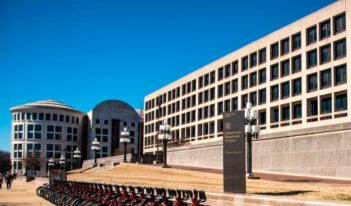
ERISA plan fiduciaries must be permitted to consider ESG factors when selecting plan investments.
The United States is experiencing a retirement security crisis, and it is important to ensure that Americans have the retirement funds they are due.
Employees who are participants in a plan regulated by the Employee Retirement Income Security Act (ERISA) enjoy certain protections, one of which ensures that those who choose how to invest the plan’s assets act with employee interests in mind, rather than their own. This protection is encompassed in the fiduciary duties of prudence and loyalty that plan administrators and trustees owe to ERISA plan participants and beneficiaries.
ERISA plan fiduciaries have an important job with a great deal of responsibility. Among other things, they are responsible for selecting and managing investments. Specifically, ERISA requires that plan fiduciaries manage plan assets “solely in the interest of the participants and beneficiaries and . . . for the exclusive purpose of . . . providing benefits to participants and their beneficiaries.”
Importantly, both ERISA’s statutory language and U.S. Supreme Court case law require that fiduciary investment decisions are made for the exclusive purpose of maximizing financial returns on a risk-adjusted basis, both to provide the financial benefits due under the plan and to cover the reasonable costs of administering the plan.
In 2022, the U.S. Department of Labor finalized a new rule on prudence and loyalty in selecting plan investments, which took effect in January of this year. This rule addresses a few things, one of which is whether and to what extent ERISA plan fiduciaries may consider environmental, social, governance (ESG) factors when selecting investments for ERISA-regulated plans. Under the new rule, plan fiduciaries are now permitted to “take into account the potential financial benefits of investing in companies committed to positive environmental, social and governance actions.”
The legal standards governing plan administrators’ consideration of ESG factors have pinballed with each administration since the Clinton Administration. In 2020, the Trump Administration enacted a rule that effectively limited ERISA fiduciaries to the consideration of ESG factors only as a “tie-breaker,” in the rare situation where two investments featured identical financial risk and returns. The rule also imposed a documentation requirement for fiduciaries to follow when using the “tie-breaker” test.
Instead of implementing a tie-breaker test, the new rule allows plan fiduciaries to consider “the economic effects of climate change” and other ESG factors as part of their risk-return analysis. It states that “a fiduciary’s duty of prudence may often require an evaluation of the economic effects of climate change and other ESG factors on the particular investment.” Importantly, the rule does not require plan fiduciaries to consider ESG factors, and it also prohibits a fiduciary from selecting an ESG investment for non-pecuniary reasons. Instead, any fiduciary who is considering relying on ESG factors must still determine that those factors are relevant to the financial success of plan assets.
Opponents of the new rule contend that it flouts ERISA provisions and Supreme Court precedents that require fiduciaries to manage plan assets for the exclusive purpose of maximizing financial returns. But, as stated above, that is not the case. There is no such requirement, period. And disregarding ESG when doing a risk-return analysis may very well diminish financial returns.
Critics also argue that the rule’s flexibility encourages fiduciaries to weigh ESG factors in a manner inconsistent with their obligation to maximize investor returns. This assertion itself is facially inconsistent with the actual text of the rule, which repeatedly requires fiduciaries to “act solely in the interest of the plan’s participants and beneficiaries, and for the exclusive purpose of providing benefits to participants.” In fact, the current rule is more laissez-faire than the 2020 rendition, as it enables fiduciaries to consider a complete range of factors when performing a risk-return analysis.
Such a range of factors is appropriate as one cannot dismiss that many companies today are incorporating ESG factors into their business decision-making. ESG often has to be considered in a risk-return analysis, otherwise such analysis would be deficient.
Consider, for example, that even some oil companies have, in different ways, taken ESG factors into account. Chevron refers to itself as “the human energy company.” It discusses ESG on its own website stating that “Chevron’s commitment to sustainability has never been stronger” and that sustainability considerations are integrated throughout its business.
The chairman of another oil company, ExxonMobil, has said that the need for a “balanced approach” to investment has “never been greater.” He also has noted that the United States saw “landmark legislation offer the policy and financial support needed to drive the growth of key lower-carbon emissions technology like carbon capture and storage” in which ExxonMobil has been an industry leader.
In weighing whether to invest in either Chevron or ExxonMobil, a fiduciary should consider all that the company is doing, including carbon capture, for example, which qualifies as an ESG factor.
But the new Labor Department ESG rule recently received congressional pushback. Earlier this year, both houses of Congress passed a joint resolution stating that Congress “disapproves the rule… and that such rule shall have no force or effect.” In March, Congress presented the resolution to President Joseph R. Biden, who subsequently vetoed it. The U.S. House was later unsuccessful at overriding President Biden’s veto.
The pushback did not stop with Congress. The rule is also being challenged in federal court by 25 states and several private entities. Detractors allege that the rule is arbitrary and capricious and will harm participants through diminished returns.
Although some believe that companies are being pushed into ESG, there are plenty of reasons that companies should incorporate ESG, one of which is to ensure the company does not become obsolete. No corporate leader wants to become the next Blockbuster video chain.
It is erroneous to assume that companies that implement ESG components into their operations are bad investments or investments that will reduce pension assets or someone’s 401(k) account. Companies such as Chevron and ExxonMobil have been expanding into environmentally sustainable systems and products. I suspect that they would want these expansions to be considered when anyone is evaluating them for investment purposes.
In addition, evaluating ESG impact as part of a risk-return analysis will be easier for fiduciaries and others in the near future. For public companies, the SEC is proposing requirements to disclose climate-related risks that are “reasonably likely to have a material impact on its business, results of operations, or financial condition.” SEC enforcement and a required disclosure mechanism will provide a more consistent presentation of information for plan fiduciaries to consider.
Because of SEC oversight, ESG disclosure will have to be substantiated, thereby reducing the potential for greenwashing. There are also increasingly popular guidance frameworks that aid businesses in identifying, managing, and reporting on their ESG performance, such as the Sustainable Accounting Standards Board, the Global Reporting Initiative, the Task Force on Climate-Related Financial Disclosures, the Climate Disclosure Standards Board, and the International Integrated Reporting Framework. Going forward, these guidelines will assist both businesses and investors, including plan fiduciaries, in evaluating risk versus return of potential investments by providing reporting consistency.
Generalizing is no way to responsibly evaluate investments. And with so many companies incorporating ESG, it would be difficult to avoid considering such components in the risk-return analyses that fiduciaries must make in fulfillment of their fiduciary duties.
The bottom line is that plan fiduciaries are responsible for maximizing and protecting plan assets. They should have flexibility in investment selection particularly as companies start incorporating ESG factors into their business models. If fiduciaries put their own interests before those of the participants, they breach their fiduciary duty and can be held accountable regardless of whether a rule requires documentation. If plan trustees do not want their plan administrators to consider ESG in their investment analysis, then they are certainly free to prohibit their administrators from doing so.
This essay is part of a five-part series entitled, ESG and Retirement Plan Investing.




